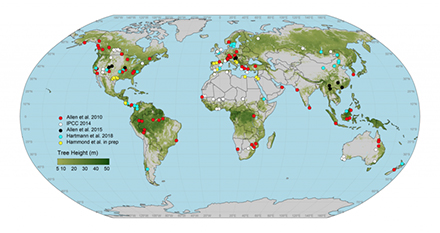Tree mortality appears to be increasing at unprecedented rates. One may be tempted to think trees regenerate, they’ll grow back. But, for a lot of reasons, it’s not quite that simple. Source: Timberbiz
“Forests are incredibly complex ecosystems that have taken centuries – even millennia – to establish,” said Dr Henrik Hartmann, of the Max-Planck Institute for Biogeochemistry in Jena, Germany. He and four deputies, Adriane Esquivel Muelbert, Aster Gebrekirstos, Nadine Ruehr and Bernhard Schuldt, are coordinating IUFRO’s Monitoring Global Tree Mortality Patterns and Trends Task Force.
“Increased tree mortality means that forests can hold less carbon for a shorter period of time. Therefore, there will be more carbon in the atmosphere with known feedback dynamics on climate warming.
“The accelerating tree mortality rates may indicate a climate change risk for forest survival. And forests are important for the Earth system and to human welfare.
“We need to know how forests will cope with the changes we are imposing on the Earth system.” (The term “Earth system” refers to Earth’s interacting physical, chemical, and biological processes.) That, Dr Hartmann says, is one of the main drivers behind his Task Force (TF).
“Trees and forests that are hundreds of years old cannot be replaced as quickly as they disappear and the migration of trees into regions that become suitable for establishment is much slower than the rate of disappearance,” he says.
“These ecosystems,” says Dr Adriane Muelbert, lecturer in Global Forest Ecology at the School of Geography, Earth and Environmental Sciences of the University of Birmingham, England, “once they are gone, or when they’re permanently disturbed, may not be able to recover, or they may recover in a very different form.
“In some cases, losing a forest may change the local conditions that allowed the forest to establish there in the first place and the forest will be unable to grow back.”
As an example, Dr Bernhard Schuldt points to the island of Haiti/Dominican Republic. There, it was human actions that made forests disappear.
“Deforestation caused intense soil erosion that still hinders forest re-establishment. There is just not enough soil to have trees regenerate and grow to maturity.
“Examples of climate-driven forest disappearance are not as well documented, as this is a rather recent scientific branch. There are indications of climate-induced desertification in the southwestern US but data are still sparse,” said Dr.Schuldt, who is with the Julius-von-Sachs-Institute of Biological Sciences, Ecophysiology and Vegetation Ecology at the University of Würzburg, Germany.
Dr Hartmann said: “This TF is tackling a timely and urgent topic – potential changes in trends of global tree mortality. Our mission is to provide an empirical basis on global tree mortality for sustainable policy making.
“This is important because currently we have no integrated large-scale assessment on the general state of our forests, despite many independent studies indicating that tree mortality is increasing.
“The TF aims to provide the information needed for today’s policy makers and forest managers to ensure forest persistence for generations to come.”
Recognizing the many challenges ahead for the TF, Dr Nadine Ruehr of the Institute of Meteorology and Climate Research at Germany’s Karlsruhe Institute of Technology in Garmisch-Partenkirchen said: “First and foremost is to be able to reach all those who can contribute to our initiative. Engaging with a global community is not straightforward. The real challenge is to be truly inclusive, going beyond the academic circle and across languages and cultures.
“Then there are huge technical and scientific challenges to harmonize different data sets that have been collected based on a variety of protocols.”
More information on the IUFRO Task Force Monitoring Global Tree Mortality Patterns and Trends:
https://www.iufro.org/science/task-forces/tree-mortality-patterns/






